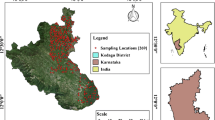Abstract
Urban models are computer-based solutions used for testing theories about spatial location and interaction between land uses and related activities. They also provide digital environments for testing the consequences of physical planning policies on the future form of cities. Earlier, 3D city models were prepared using stereo aerial photography, topographic data and conventional surveying. The geospatial information was extracted using either visual or digital classification techniques. Presently the 3D city models is prepared with the help of ALTM data along with very high resolution imagery, which is costly and time consuming. As alternatives, Cartosat-1 stereo data of the order of 2.5 m resolution, it becomes more practical and economical to generate digital surface model (DSM) with an accuracy of 4 m. Cartosat-II data with 1 m resolution fused with LISS-IV data give high resolution images for building footprint extraction. The availability of high resolution Cartosat-I stereo satellite data assists urban planners and municipal authorities to create a model and visualize the urban space in three dimensions. 3D visualization models have a variety of applications in urban studies. The studies includes urban morphological mapping, disaster management, updation, virtual reality and generation of fly through etc. The primary interest of the planners is not limited towards the extraction of urban features from satellite data. Planners also have interest in creation of 3D models of buildings and terrain surface for detailed urban planning. Therefore, to develop 3D city models 2.5 m Cartosat-1 stereo data fused with 1 m merged product of Cartosat-II and LISS-IV to create DSM and building footprints respectively. Keeping the significance of use of stereo satellite data, an attempt has been made to generate a 3D building model for Ahmedabad and Hyderabad cities. The 3D building model generated by employing geoinformatics techniques with Level of Details (LOD-1). The primary aim of this study was to develop geoinformatics techniques for the extraction of urban features based on object oriented classification techniques with level of details 1 (LOD-1) using photogrammetric DEM. This paper discusses all these techniques and their usefulness in 3D city modeling exercises.










Similar content being viewed by others
References
Döllner, J., T. H. Kolbe, F. Liecke, T. Sgouros, & K. Teichmann (2006). The virtual 3D city model of Berlin - managing, integrating, and communicating complex urban information. In: Proceedings of the 25th International Symposium onUrban Data Management, UDMS 2006, Aalborg, Denmark.
Flanders, D., Hall-Beyer, M., & Pereverzoff, J. (2003). Preliminary evaluation of eCognition object-based software for cut block delineationand feature extraction. Canadian Journal of Remote Sensing, 29(4), 441–452.
Forkert, G. (2006). Modellierung und Verwaltung von U-BahnanlagenimRahmen des digitalen 3D Stadtmodells. CORP,Vienna, Austria, CORP-Competence Center of Urban and Regional Planning.
Forkert, G., Haring, A., Sükar, G. (2005). Der Einsatz von Fahrzeug-gestütztem 3D-Laserscanning fürkommunaleAnwendungen. AGIT, Salzburg, Austria, Wichmann.
Göbel, R. & N. Freiwald (2008). Texturenfür 3D-Stadtmodelle - Typisierung und Erhebungsmethodik. CORP, Schwechat,Austria, CORP-Competence Center of Urban and Regional Planning.
Hamilton, A., Wang H, Tanyer A. M, Arayici Y, Zhang X & Song Y (2005). “Urban information model for city planning.”ITcon Vol. 10, Special Issue “From 3D to nD modelling”: 55–67.
Holzer, J. & G. Forkert (2004). EffizienteErzeugung von 3D StadtmodellenausvorhandenenVermessungsdaten. CORP &GeoMultimedia, Vienna, Austria, Selbstverlag des Institutsfür EDV-gestützteMethoden in ArchitekturundRaumplanung der TechnischenUniversität Wien.
Kolbe, T. H., Gröger, G., Plümer, L. (2005). CityGML-Interoperable Access to 3D City Models. International Symposium on Geo-Informationon Disaster Management, Delft, the Netherlands, Springer.
Li, J., & Chen, W. (2005). A rule-based method for mapping Canada’swetlands using optical, radar and DEM data. International Journal of Remote Sensing, 26, 22,5051–5069. doi:10.1080/01431160500166516.
Myint, S. W., Gober, P., Brazel, A., Grossman-Clarke, S., Weng, Q. (2011). Per-pixel vs. object-based classification of urban land cover extraction using high spatial resolution imagery. Remote Sensing of Environment. doi:10.1016/j.rse.2010.12.017.
Rottensteiner, F. (2003). Automatic Generation of High-Quality Building Models from LIDAR Data. IEEE ComputerGraphics and Applications, 23(6), 42–51.
Steidler, F. & M. Beck (2005). Cyber City Modeler: Automatic Texturing of 3D City Models; TerrainView-Web: 3D Web- VRGIS. CORP & GeoMultimedia, Vienna, Austria, Selbstverlag des Institutsfür EDV-gestützteMethodeninArchitektur und Raumplanung der TechnischenUniversität Wien.
Tao, C. V., & Hu, Y. (2002). Updating solutions of the Rational Function Model using additional control information. Photogrammetric Engineering & Remote Sensing, 68(7), 715–723.
Tao, C. V., Hu, Y., & Jiang, W. (2004). Photogrammetric exploitation of IKONOS Imagery for Mapping Application. International Journal of Remote Sensing, 25(14), 2833–2853.
Acknowledgments
The present work was carried out as TDP R&D activity at Space Applications Centre (ISRO), Ahmedabad. Authors acknowledge the support given by CEPT University, Ahmedabad and JNT University, Hyderabad for completion of this project. The authors are thankful to Shri AS Kirankumar, Director, SAC and Dr J.S. Parihar, Deputy Director, EPSA for their encouragement and guidance during the course of the present work. Authors are also thankful to Late Dr S. K. Pathan for his initiative for this project.
Author information
Authors and Affiliations
Corresponding author
About this article
Cite this article
Sharma, S.A., Agrawal, R. & Jayaprasad, P. Development of ‘3D City Models’ using IRS Satellite Data. J Indian Soc Remote Sens 44, 187–196 (2016). https://doi.org/10.1007/s12524-015-0478-9
Received:
Accepted:
Published:
Issue Date:
DOI: https://doi.org/10.1007/s12524-015-0478-9




